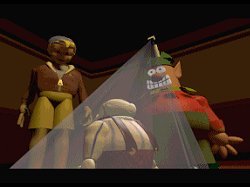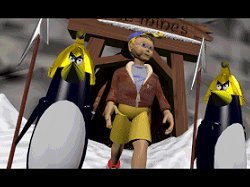|
Spud
 After having a riotous time playing The Quivering a while back I was going to take a look at Spud, an earlier game by the same developer. Unfortunately the game's insistence on me installing a primitive DirectX before it would run meant that I wasn't prepared to mess around, so Spud got shelved. Then in January this year one of our PCs blew up (sparks, smoke, everything!) and it had to be replaced. So, whilst waiting for a new one, I decided at long last to put together an old DOS/Windows PC (made up of bits and pieces from numerous old machines) for playing old games. Once it was up and running I needed an old game to test it, and Spud was it.
Though made for DOS and Win 95 I installed it under Win 98 and let it install DirectX 2. It worked just fine with no additional tweaking. After having a riotous time playing The Quivering a while back I was going to take a look at Spud, an earlier game by the same developer. Unfortunately the game's insistence on me installing a primitive DirectX before it would run meant that I wasn't prepared to mess around, so Spud got shelved. Then in January this year one of our PCs blew up (sparks, smoke, everything!) and it had to be replaced. So, whilst waiting for a new one, I decided at long last to put together an old DOS/Windows PC (made up of bits and pieces from numerous old machines) for playing old games. Once it was up and running I needed an old game to test it, and Spud was it.
Though made for DOS and Win 95 I installed it under Win 98 and let it install DirectX 2. It worked just fine with no additional tweaking.
If you have played The Quivering you will instantly recognise its genesis in Spud. It has the same inventory system and the same unsubtle humour although it's not as sharp as in The Quivering so the laughs don't come as often. This is partly because the more primitive graphics don't carry it so well.
Even Spud himself is a younger 'nicer' version of the sarcastic character who graced our screens in The Quivering. It makes you wonder what happened to him between games. Having said that, Spud the younger does visually display his 'attitude' by wearing his cap backwards and a couple of characters in the game can't resist commenting on it. But when you remember that this game was made in 1995 it means that any young male today who wears his cap backwards is seriously out of date. 'Old hat' so to speak.
But enough of my out-moded sartorial musings. Spud the eponymous hero of this game learns, courtesy of an image projected from a Gnome 2 Unit, that his kindly old grandfather has been kidnapped and you, Spud, are his only hope. The more perceptive among you may notice something vaguely familiar about this occurrence, and about Spud's grandfather who is a rotund, white-whiskered gentleman whose 'hobby' is making toys for "good girls and boys".
It seems that grandfather's toy factory at the North Pole has been attacked by the evil Doctor Chillblane who has stolen the magic toy making machine and converted it for his own malevolent purposes. So your task is to find and rescue your grandfather and put a stop to Doctor Chillblane's plot to create an army of evil, mutated toys.
 Spud is a first person perspective, point and click adventure with occasional third person cut scenes. You can pan around 360 degrees but you can't look up or down. Navigation is perfectly straightforward as a large red arrow indicates where you can go. Most of the interface is fairly intuitive with the exception of the inventory. If you have played The Quivering you'll know what to expect. A right click changes the cursor to your inventory box or 'cube' then you left click when this icon appears to enter the Tardis-like inventory workspace. Here you can save and load your game (only three slots provided but this is plenty for this game) and you can also equip your gnomes and pink fluffy bunnies with inventory items to carry out various actions. The good news is that you don't need to use a gnome or a bunny in order to save unlike the imps in the later game.
The game starts off easily enough as you explore your grandfather's home and workshop picking up gnomes and bunnies as you go. Make sure you get them all as you won't find any more later. Your main task here is to get the attention of several familiar but preoccupied reindeer so that they will pull a sleigh and you Southwards on your quest.
Alas, Doctor Chillblane rudely interrupts your journey so that you need to find a way to leave a tropical island before you can travel on. This problem solved and that's the end of CD 1 and you will be given a code so that you can play CD 2 which is set at the South Pole and is the biggest and most complex part of the game, and where the going gets tougher. Spud is a first person perspective, point and click adventure with occasional third person cut scenes. You can pan around 360 degrees but you can't look up or down. Navigation is perfectly straightforward as a large red arrow indicates where you can go. Most of the interface is fairly intuitive with the exception of the inventory. If you have played The Quivering you'll know what to expect. A right click changes the cursor to your inventory box or 'cube' then you left click when this icon appears to enter the Tardis-like inventory workspace. Here you can save and load your game (only three slots provided but this is plenty for this game) and you can also equip your gnomes and pink fluffy bunnies with inventory items to carry out various actions. The good news is that you don't need to use a gnome or a bunny in order to save unlike the imps in the later game.
The game starts off easily enough as you explore your grandfather's home and workshop picking up gnomes and bunnies as you go. Make sure you get them all as you won't find any more later. Your main task here is to get the attention of several familiar but preoccupied reindeer so that they will pull a sleigh and you Southwards on your quest.
Alas, Doctor Chillblane rudely interrupts your journey so that you need to find a way to leave a tropical island before you can travel on. This problem solved and that's the end of CD 1 and you will be given a code so that you can play CD 2 which is set at the South Pole and is the biggest and most complex part of the game, and where the going gets tougher.
The puzzles generally involve finding and using inventory items but you should remember that some items need to be given to a gnome (or a bunny) so that they can carry out particular, and sometimes dangerous, actions. Most of the puzzles are not too difficult to work out except for one or two areas where there is no indication that an action is possible. More feedback at those times would have improved matters. There is also a nasty 'maze' where you must quickly navigate the paths around a pixie dormitory lined with bunks in near dark conditions, all the while avoiding the playful pixies who are out to kill you. I must admit that after a few failed attempts I reached for a walkthrough as I find this sort of obstacle course far too frustrating. You can die quite often, especially during the last half of the game but after the dreaded 'Game Over' sign you are quickly restored to just before you made the fatal move so you can try again.
The graphics are blurry though adequate for the game, but dated by today's standards of course. There are some humorous touches in the descriptions and dialogue and in such puzzle sequences as the one that parodies the opening to Raiders of the Lost Ark. But overall Spud (the character and the game) lacks real substance. I'm not sure that Spud even speaks as the voice providing descriptions sounds like a crusty old codger. Conversations are limited, click on a character and listen to what they say. There are no subtitles and I missed this at times when I was unsure of what a character had just told me. This was especially noticeable during the Brando-esque mumblings of the Emperor Penguin.
Spud is a mildly entertaining diversion especially if the thought of tackling The Quivering seems too daunting a task. It is fairly 'basic' and it would probably have been basic at the time of its release when you think of some of its contemporaries such as Terry Pratchett's Discworld or Woodruff and Schnibble, but it does have its own brand of humour and it was made by a much smaller development team. It's also interesting from a historical perspective to see how the developers built upon it to produce the more substantial and ultimately more satisfying tale of The Quivering.
Copyright © Gordon Aplin 2004.
All rights reserved.
System Requirements:
DOS 6.0, Windows 95/98, Pentium 75 MHz or higher (133 MHz recommended) 16 MB RAM (32 MB recommended) 4X CD-ROM drive, Mouse, Video card, 640x480 resolution, SVGA 256 colors or higher, Soundblaster-compatible 16-bit sound card, Speakers.
|

